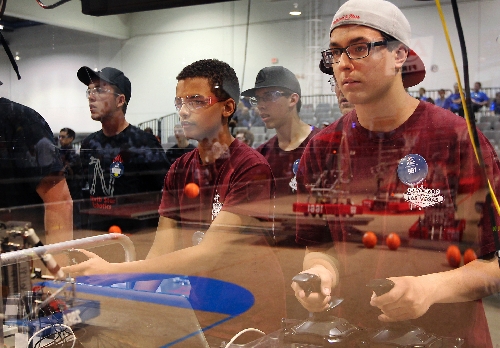Cimarron-Memorial robotics team rolls into excellence
Like a zany Japanese game show, you don't know what to think of it.
Two boys in spandex tuxedos dance erratically on the bleachers, their faces hidden behind white skintight hoods.
About 20 high school students jump up and down, oversized Uncle Sam hats bobbing on their heads.
A team in blue togas dances courtside in choreographed unison to the kitschy 1980s pop of Rick Astley. "Never gonna give you up. Never gonna let you down. Never gonna run around and desert you."
The emcee , sporting Elton John sunglasses and a feather boa, counts down to the start of an unusual basketball game.
Three.
Two.
One.
The crowd chants for each basket the athletes -- which are robots -- score. Six of them zigzag across the court.
At the joysticks of Robot 987 stands Jacob Mauro of Cimarron-Memorial High School, unsmiling, focused as he maneuvers Team High Rollers' 119-pound robot toward the highest of the four hoops. At 8 feet high, it's worth the most points. Teams rarely make it. But Cimarron aims nowhere else.
Their robot's shooting percentage is just a few points from perfect, which explains why the northwest valley high school team came into this weekend's Las Vegas Regional FIRST Robotics Competition as the only undefeated team out of more than 2,000 in the world. In 2007, Cimarron's team won the world title. Last year, its team placed third at the world championship.
PROGRAMMED FOR SUCCESS
The 2012 team had already won a place at the world championships with 15 wins and zero losses in the Los Angeles regional. But team members didn't want to miss out on their own Las Vegas regional at Cashman Center, which drew 42 teams from Oregon, Utah, Colorado, Wyoming and Mexico. And they defended their home turf, winning the regional on Saturday.
Mauro, team president and a Cimarron-Memorial senior, guides the bot to three basketballs, which ascend a conveyor belt to be fired through a custom pitching machine. Teammate and programmer Brandon Hjelstrom fires.
All three balls bounce perfectly off the backboard and into the hoop. There's no guesswork. Hjelstrom's programming takes human error out of the equation. The bot senses the distance and position of the rim and adjusts the pitching machine's flywheel speed.
Final score for Friday's first 2 minute, 15 second match: 35--3. Seven more to go before finals.
"It's a sport of the mind, the only place where being a geek can really be cool," says organizer Jean Hoppert back at the pits. Like NASCAR, each team has a pit for all their tools, computers and parts to work on their robots between matches. While other teams rush to put together broken arms and abandon designs that aren't working, Cimarron just replaces the battery with a fresh one and shoots the breeze.
"It wasn't always like this," notes team mentor and mechanical engineer Martin Lewis. "We were dragging parts back to the pit. Things blew up. Boring is a little better than super-exciting."
The team of 25 students and seven mentors has learned a lot in its 11 years despite constantly changing its teammates who graduate, says head coach, co-founder and science teacher Marc Rogers. Weld the frame. Don't bolt it. They customized their drivetrain as well and can push an obese man four feet per second.
"It could push a semi truck," Mauro says. "Just kidding."
HIGHLY ORGANIZED ACTIVITY
Eighth-grader Brendan Mulcahy isn't on the team yet but is in training. He's not zoned for Cimarron-Memorial but obtained a zone variance so he can be on the team next year.
Team High Rollers even places a dozen players as "scouts" in the bleachers with laptops, recording every stat of every bot. The teams are pitted against each other in matches of three-on-three, explains Cimarron senior Hunter Wallace, one of the few girls on the competing teams. After each match, a scout hands a report to coach Rogers listing the strengths and weaknesses of the next match's competitors and allies.
All the stats go into spreadsheets ranking teams and talents. During finals on Saturday, the rankings came in handy when the top eight teams selected two teams as allies during the three-on-three matches.
A lot of work goes into reaching the finals.
Starting in January, the team squeezed 1,000 working hours into just six weeks to design and build a $3,500 custom robot, often working until after midnight school day after school day at Cimarron-Memorial's converted wood shop.
They discovered the school alarm is activated at 11:30 p.m. after they set it off. Police would show up 15 minutes later and sometimes hang around to see their work, fascinated.
"It's not really known that robotics is now a high school activity," notes senior Chad Pesquera, team vice president.
But the activity's impact is life altering. No exaggeration, claims mentor and advanced placement physics teacher Eric Stensrud. Half of Cimarron's 2,600 students live in poverty and only two out of three graduate.
However, mentor teachers have found that 100 percent of the team graduates. About 95 percent go on to college.
"Every one of these kids gets into the school of their choice," Stensrud says.
Unlike regular sports, students have to pay their way in robotics competitions.
"At our school, anything over $150 is out of the question for kids," Stensrud says.
But the team needs $70,000 a year for all their technology, materials and traveling. Their success has attracted sponsors like ITT, Yesco, Albertsons and Cox Communications. Students also do a lot of fundraising, including a summer camp, which is expected to bring in $20,000 this year, Wallace says. They also do a lot of charity work and host middle school robotics competitions.
Even better, they develop ambitions many of the underprivileged students didn't have coming into high school.
"We're not really educating kids here," Hoppert says of the competition. "We're inspiring them."
Contact reporter Trevon Milliard at tmilliard@reviewjournal.com or 702-383-0279.






















